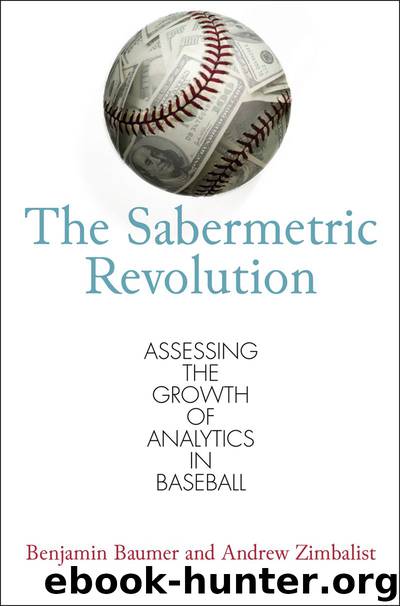The Sabermetric Revolution: Assessing the Growth of Analytics in Baseball by Baumer Benjamin & Zimbalist Andrew

Author:Baumer, Benjamin & Zimbalist, Andrew [Baumer, Benjamin]
Language: eng
Format: epub
Publisher: University of Pennsylvania Press
Published: 2013-12-31T00:00:00+00:00
The Spread of Analytics Outside Baseball
Similar to baseball, it is not a simple matter to identify when the application of critical statistical analysis of performance and strategy was first introduced into the front offices of football, basketball, or other sport teams. Some teams did hire statisticians decades ago, but whether these employees did more than assemble the basic box scores and maybe add a few tweaks, and how any of this information was put to use, is more difficult to discern.
For instance, the NBA’s New York Knickerbockers hired Dave Heeren in 1961 as the team statistician. In 1958, Heeren had developed what he called the TENDEX formula for evaluating players.4 In its initial version, a player’s TENDEX rating equaled the sum of his points, rebounds, and assists, minus missed field goal attempts and missed free throw attempts. Heeren evolved the formula into more sophisticated versions over the years. TENDEX became the basis for the NBA Efficiency rating and for subsequent linear weights metrics of player and team performance. It is unclear, however, to what extent the Knicks or any other team made effective use of this rating system, and, as we shall see, the various incarnations of linear weights in basketball all have significant limitations.
Heeren did not begin to publish articles on his system until the late 1980s. He published his first TENDEX book in 1989. Dean Oliver, Bob Bellotti, and John Hollinger began writing in the 1990s, primarily on websites, suggesting various refinements and elaborations to TENDEX, as well as other evaluation methodologies. The proliferation of articles, books, and websites using quantitative analysis of basketball, however, did not begin until after 2000.
Also after 2000, NBA front offices began to embrace the notion that they could improve team performance by a more sophisticated application of statistical analysis. The practice of basketball analytics has evolved cautiously since then. Soon after he purchased the Dallas Mavericks in 2000, Mark Cuban hired decision sciences professor Wayne Winston, his former teacher at Indiana University, as a stats consultant. Cuban seems to have been first basketball owner to explore the application of analytics. Cuban’s explanation for his innovative move is straightforward: “I wanted to give the Mavs any advantage that I possibly could.”5
Upon finalizing his purchase of the Celtics in January 2003, Wyc Grousbeck hired Daryl Morey as vice president of strategy and information to do statistical analysis. Grousbeck’s background was in biotech and software venture capital. He realized that the Celtics’ front office was in dire need of overhaul and modernization, and he wanted to exploit every opportunity to give his team a leg up on the competition. One of the first statistical insights to benefit the Celtics was the discovery that twenty-four of the previous twenty-five NBA champions had three all-star players on their roster,6 and, most important, one of the three was a league MVP or Top Fifty all-time player. Eventually this insight led to the Celtics’ plan to get Kevin Garnett.
In October 2004, the Seattle SuperSonics hired Dean Oliver as a full-time quantitative analyst.
Download
This site does not store any files on its server. We only index and link to content provided by other sites. Please contact the content providers to delete copyright contents if any and email us, we'll remove relevant links or contents immediately.
Life 3.0: Being Human in the Age of Artificial Intelligence by Tegmark Max(5193)
The Sports Rules Book by Human Kinetics(4079)
The Age of Surveillance Capitalism by Shoshana Zuboff(3991)
ACT Math For Dummies by Zegarelli Mark(3855)
Blood, Sweat, and Pixels by Jason Schreier(3498)
Unlabel: Selling You Without Selling Out by Marc Ecko(3474)
Hidden Persuasion: 33 psychological influence techniques in advertising by Marc Andrews & Matthijs van Leeuwen & Rick van Baaren(3302)
Urban Outlaw by Magnus Walker(3246)
The Pixar Touch by David A. Price(3220)
Bad Pharma by Ben Goldacre(3102)
Project Animal Farm: An Accidental Journey into the Secret World of Farming and the Truth About Our Food by Sonia Faruqi(3019)
Brotopia by Emily Chang(2899)
Kitchen confidential by Anthony Bourdain(2834)
Slugfest by Reed Tucker(2807)
The Content Trap by Bharat Anand(2781)
The Airbnb Story by Leigh Gallagher(2707)
Coffee for One by KJ Fallon(2423)
Smuggler's Cove: Exotic Cocktails, Rum, and the Cult of Tiki by Martin Cate & Rebecca Cate(2340)
Beer is proof God loves us by Charles W. Bamforth(2252)
